“This issue marks 100 years of continuous publication of The Eleusis. We should all be proud – not many magazines have been around for 100 years. Perhaps the secret of its longevity is that The Eleusis was founded not just as a house organ to talk about ourselves. Instead, from the beginning, The Eleusis has maintained a policy of devotion to the cause of information and enlightenment…” Christine Thomas Barnicki, editor of The Eleusis, in the 1999 issue commemorating 100 continuous years of publication.
The First Publication
In 1899, 100 years prior to this centennial milestone and 120 years prior to our issues today, Ida Pace Purdue, an English professor and Psi alumna, was appointed as the first editor of what would become a pinnacle of Chi Omega’s connectedness. Several names were stirred around when discussing what to call the publication including Messenger and Chi Omega Quarterly, but it wasn’t until Dr. Richardson suggested The Eleusis, a Greek city named in honor of the son of Mercury, the messenger of the Gods, that one was agreed upon. Hence, the name of Chi Omega’s messenger would be The Eleusis.
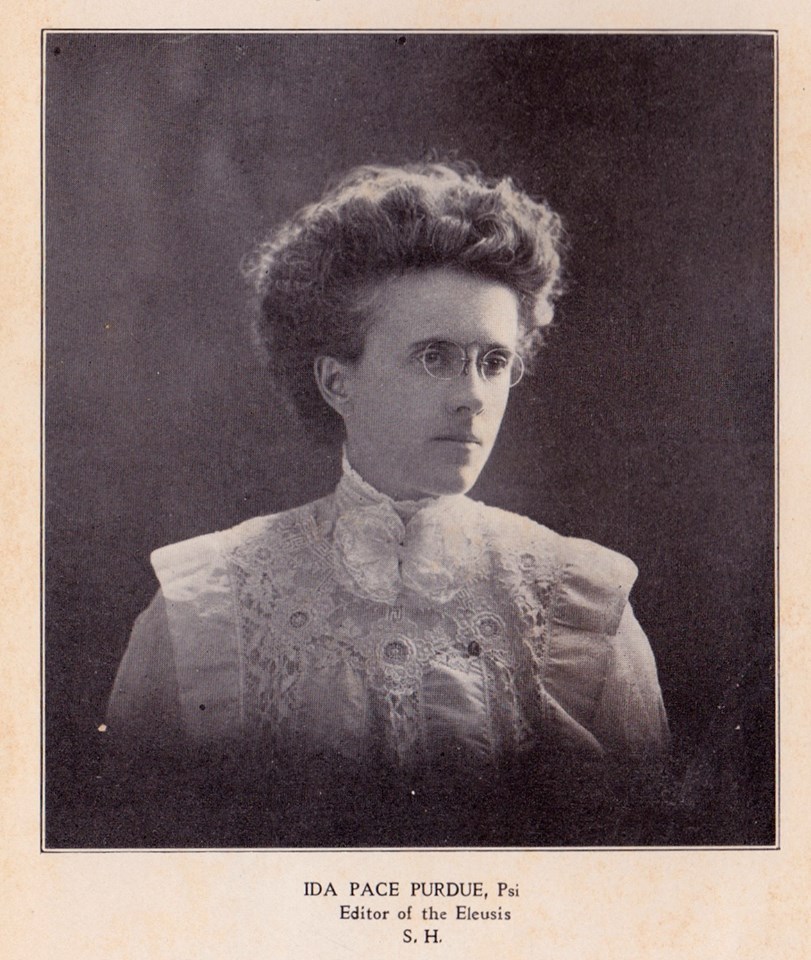
The very first issue of The Eleusis was published in the summer of 1899 when there were just 64 initiated members and was paid for by Psi chapter.
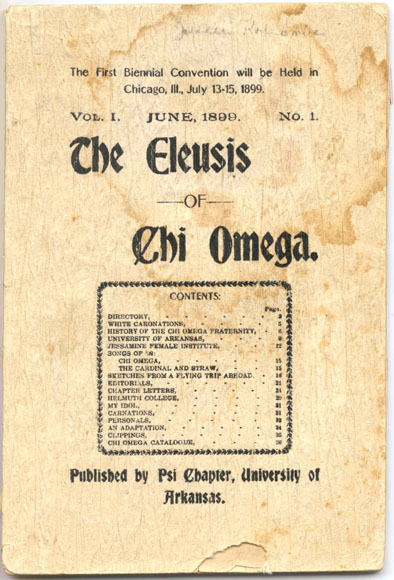
Thirty-seven pages in length, “…the first issue contains an account of Chi Omega’s Founding and pictures of the five Founders, histories, and photos of the three chapters, a directory of members and their cities of residence, and three Chi Omega poems… The first issue also contains one and two-line personals about alumnae members’ graduate studies, new homes, careers, and travels. In the personals section, the first Chi Omega marriage is reported – that of Founder Alice Cary Simonds on November 6, 1898,” Christine Barnicki stated in the 1999 commemorative issue.
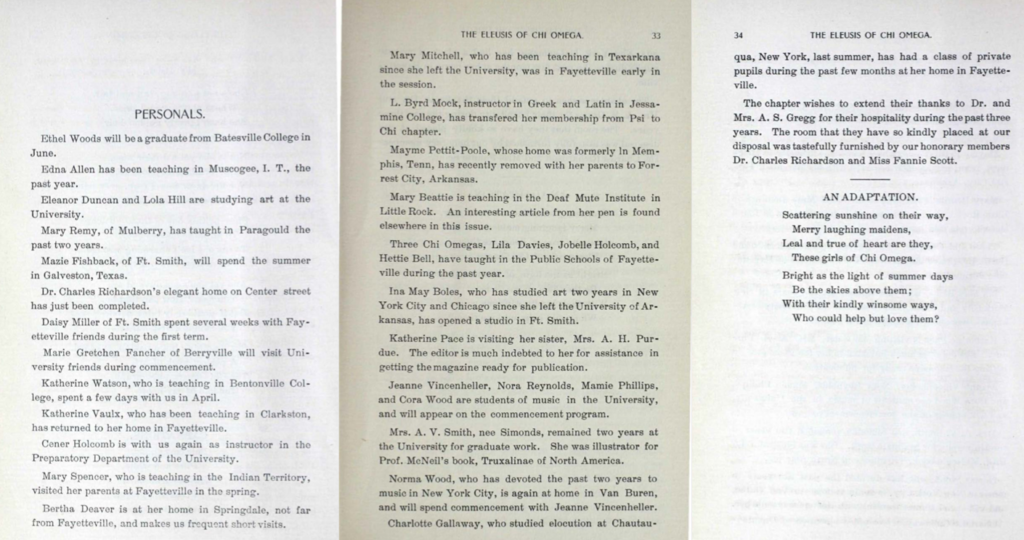
After Psi paid for the first issue, the subscription fee rang up at $1 a year and peaked at $3 annually for each member. Today, The Eleusis is sent to all alumnae and collegians, serving as a point of contact that the Fraternity treasures with each Sister, regardless of whether or not she pays a subscription fee.
From the first issue, The Eleusis was well received in the Greek community. It soon began to be quoted by other fraternity publications and one magazine writer commented, “We admire the courage of a young society in maintaining such a creditable magazine when its membership roll is so short.”
Articles during these early years reflected the need of the young organization to showcase its purposes and the benefits of membership, and all pieces were written by Chi Omegas.
In one of her final editorials, Ida Pace Purdue wrote: “The Eleusis has never had a wastebasket. Why? Because one has never been needed. Not every article has been printed in the form in which it was received, but it has been used.”
Passing the Torch
When Ida Pace became S.H., Mattie Craighill, who had stood out thanks to her contributions as Sigma chapter correspondent, was appointed as the new editor. At this time the editor was a member of the Governing Council, so Mattie did not take this appointment lightly. Ida Pace and Mattie’s work were so well received that Mary Love Collins, who would go on to be a long-time S.H., noted it was The Eleusis that influenced her local sorority at Dickinson College to apply for a Chi Omega charter.
During Mattie’s time, she introduced more pictures and department headings inspired by Greek design and drawn by Ina May Boles.

She also enacted the requirement for collegiate chapters to submit three times a year and alumnae chapters to submit once a year with the looming consequence of being on suspension if not fulfilled. Today, thanks to technology and the ease of sending a quick email, our editor receives so much content that her inbox overflows with all the wonderful accomplishments and endeavors our Sisters submit for publication!
“The tenor of the magazine changed radically and immediately after Mary Love Collins became Fraternity president in 1910. Reflecting the ideals of our new SH, The Eleusis suddenly became serious in nature, seldom featuring any frivolity. Gone were pleas for member-written material and articles on sorority and campus life. Now, in an average of six to eight features per issue, and with an ever-increasing percentage of articles authored by non-Chi Omegas, the magazine discussed the importance of education to train a woman’s intellect and character, her place in the contemporary world, and the endless possibilities for her future,” Christine Barnicki stated in the 1999 commemorative issue.
The Eleusis then began focusing more on public service, professions, the encouragement of women to find their niche instead of settling for the traditional roles of women in society, and advocating for the political equality of the sexes. Even the chapter letters began to be more tuned into the service endeavors than social. Scholarship accomplishments and the benefits of Greek life were featured frequently. World events, most notably World Wars, were also referenced, as it had taken over much of life for all in this time.
The Blue Books
In 1925, under Mattie’s watchful eye, the unforgettable and highly recognizable blue covers were introduced. This came with fewer pages and smaller text, and most all features authored by non-Fraternity members focusing on civilization and culture, psychology, hobbies, travel, art, reading, religion, and articles of interest to teachers.
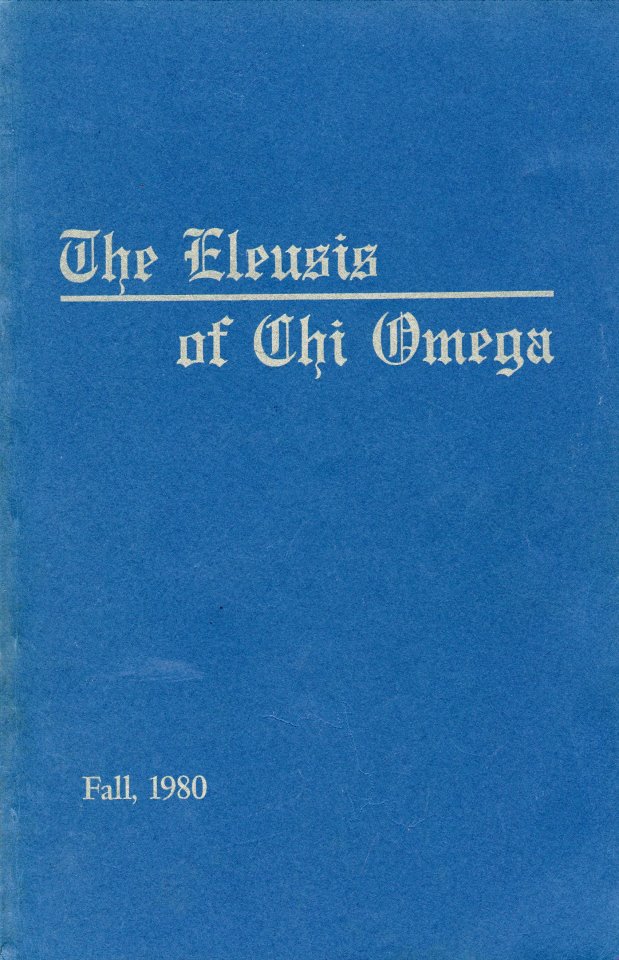
Next, Christelle Ferguson was appointed as long-time editor from 1932-1968. She continued to mirror the topical focus that Mary Love Collins had established previously, including events like The Great Depression, World War II, the Cold War, and student rebellion on campuses nationwide.
Modernizing the Publication
When Eleanor “Bunny” Bailey Hyatt was chosen as the next editor of The Eleusis in 1975, many changes came with her to the Chi Omega’s beloved publication.
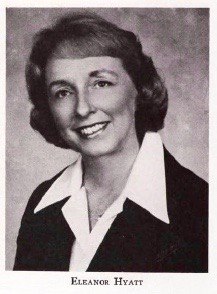
In 1983 she began a year of introducing yellow, orange, and green covers, a sharp contrast to the blue that had been delivered to Sisters’ mailboxes for decades. In the summer of 1985, she championed the introduction of the glossy magazine-style publication we know today. Although color was not used on every page, the cover and several pages throughout boasted beautiful color images that impressed Sisters across the nation.
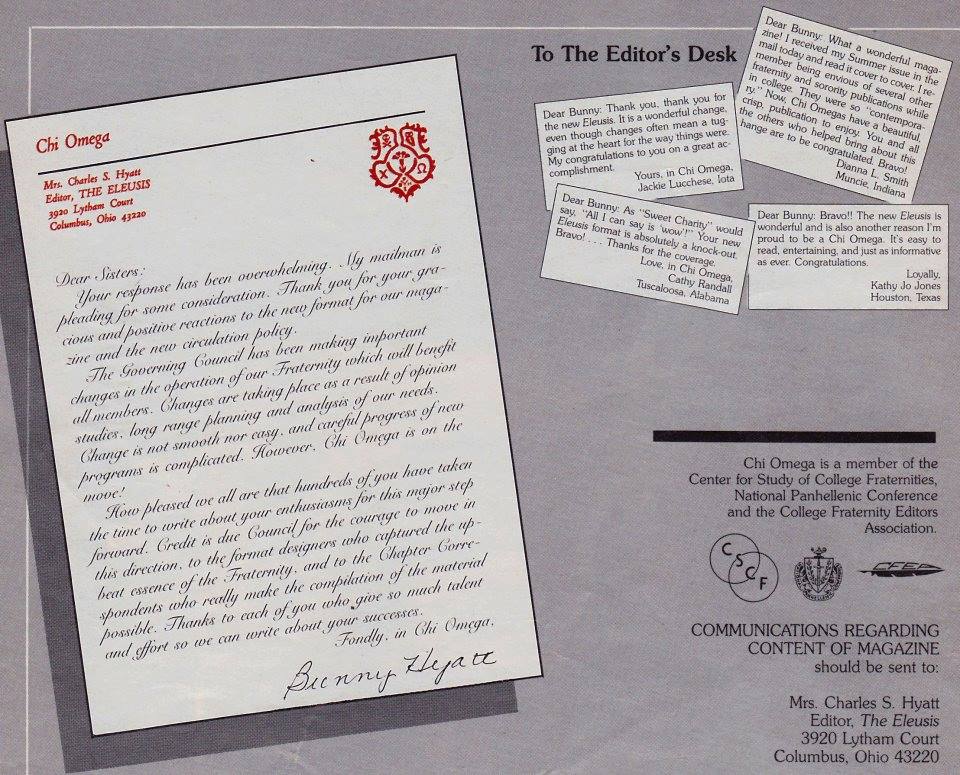
Patty Disque, who was S.N.V. at the time has said, “When Bunny Hyatt went to the Editors meetings at NPC that year, the editors gave her a funny plaque as an award for Chi Omega finally “joining the 20th Century”. We were definitely the only group that did not have one of the slick, colorful magazines.”
This also came the same time as the subscription fee was dismissed, allowing all members with an address on file to receive her copy of The Eleusis free of charge.
The Eleusis Today
Today The Eleusis is mailed to over 200,000 members twice a year and continues to connect Chi Omegas to the national organization by promoting our common experiences, communicating the state of the Fraternity, affirming our values and purposes, highlighting our success stories, and providing resources for the development of women. The most recent issues can be found here, and you can update mailing addresses on your profile here to make sure you are receiving your issue in the mail.

Today, 120 years later, we have the editors of The Eleusis to thank for upholding the standard of excellence that we as Chi Omegas expect in all that we do. Those known editors include: Ida Pace Purdue (1899-1904), Mattie Craighill Nicholas (1904-1910), Martha Land (1912-1920), Eleanor Lewis (1920-1924), Helen Nieman Skeer (1924-1932), Christelle Ferguson (1932-1968), Betty Boaz Thomas (1968-1975), Eleanor “Bunny” Bailey Hyatt (1975-1986), Christine Barnicki (1991- today).
“The Eleusis’s devotion to information and enlightenment has been steadfast. Since its premier issue in 1899, its pages have featured women’s issues, education, Greek matters, Fraternity business, Foundation programs, and items of interest to both our collegiate and alumnae members. It continues to stand the test of time as Chi Omega’s outward and visible representative, mirroring the deeds of Sisters and our Fraternity’s leadership, ideals, goals, and ambitions. As toay’s editor, I am personally and professionally gratified to be a part of this long and admirable history. Going forward, it is my hope that The Eleusis will continue to reflect our Sisters’ traditions of pride in the Fraternity and its purposes.” Christine Barnicki.
